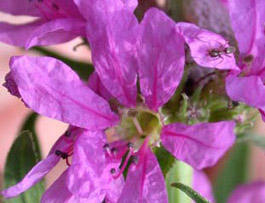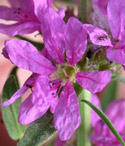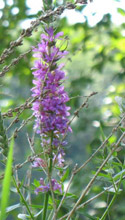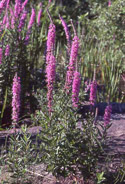Purple Loosestrife
| Description: |
Established plants grow to heights of 4 to 10 feet high and produce a showy display of magenta colored flower spikes throughout the summer. Short slender branches spread out to form a crown of up to 5 feet wide on established plants. Its somewhat square-ish stems are 4 to 6 sided, with evenly spaced nodes. Stems that are submerged in water develop the tissue characteristic of aquatic plants. Its leaves are lance shaped to heart shaped, its lower leaves are larger and smooth, while upper leaves are smaller and covered in fine hairs. |
||||
| Why Is it a Noxious Plant? |
Purple Loosestrife is highly invasive and crowds out native vegetation. It thrives on moist or saturated soils, and is a very hardy perennial which can rapidly degrade wetlands, diminishing their value for wildlife habitat by replacing native plants used for ground cover, food or nesting material. Purple loosestrife catches soil and debris that accumulate and increase the elevation of the land. Eventually, the soils dry, and the wetland is displaced. |
||||
| Where Does it Grow? |
It is found in fresh water and brackish wetlands. It is a successful colonizer and potential invader of any wet disturbed site. |
||||
| Facts: |
Purple Loosestrife is a prolific seed producer and spreads primarily by floating seeds. One plant can produce more than 2 million seeds annually. Warm temperatures and open, moist soils are required for successful germination. |
||||
| Control Options: |
Cutting, mowing or digging purple loosestrife is only partially effective. Though these methods can reduce or prevent seed production, the plants usually re-sprout. Also, the access issues involved with purple loosestrife make these techniques difficult.
|
||||
| More Information: |
Download our Flyer or visit Washington State Noxious Weed Control Board Here. Photo by Leo Michels
|
||||
| More Pictures: |
|







 Pierce County Noxious Weed Control Board • 9200 122nd St E, Puyallup, WA 98373 • 253-798-7263
Pierce County Noxious Weed Control Board • 9200 122nd St E, Puyallup, WA 98373 • 253-798-7263